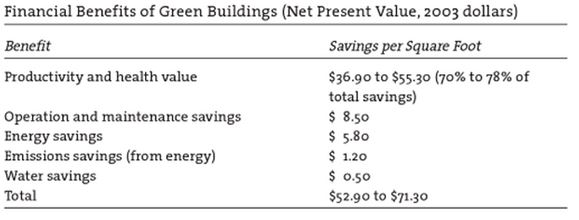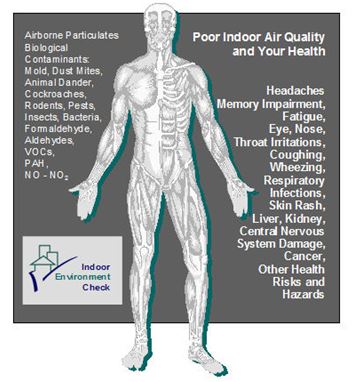Abstract
Green building movement is one of the most topical issues nowadays. It addresses many environmental issues and human health problems. Despite its quite long history, the movement has gained its high status in society only a decade ago. The hypothesis of the present research can be formulated as follows: Indoor air quality can be increased with the help of green building, and this positively affects people’s health.
The hypothesis is proved to be true since numerous data suggest that high indoor air quality is beneficial for people since it decreases the number of health threats and leads to budget savings. More so, nowadays air quality is one of the major concerns of the green building movement, so numerous effective strategies are being worked out. Thus, indoor air quality is regarded as one of the most important elements of the green building movement which is beneficial for people from different perspectives.
Introduction
The development of science and technology has brought many opportunities for construction, but has led to numerous environmental problems and human health issues. Fortunately, people have found the way to minimize the construction negative impact on the environment and people’s health as well. Green building is this fortunate way. On one hand, green buildings improve environmental situation due to the use of environmentally friendly products while construction.
On the other hand, the use of “green products” during construction positively affects people’s health, since they are not harmful, in contrast to the products containing chemicals. More so, it is important to point out that green building pays much attention to indoor air quality which is crucial for human health.
The hypothesis of the present research can be formulated as follows: Indoor air quality can be increased with the help of green building, and this positively affects people’s health.
To check the hypothesis it is necessary to consider such issues as the history of green building, the impact of green building on environment and people’s health, the importance of the high indoor air quality in houses and, finally, the role of the green building in the indoor air quality increase.
The history of “green building”
The history of the U.S. green building can be traced back as far as 1970s when “Arab-Israeli conflicts resulted in a flowering of innovations in energy conservation and renewable energy systems” (Kibert and Kibert 4). Thus, many standards as for building energy saving efficiency were enacted in the 1970s. After the fuel crisis ceased to exist, energy saving building also declined. However, environmental concerns came into place.
This led to the development of green building movement which started in the late 1980s when “society began to seriously consider complex global environmental issues” (Kibert and Kibert 4). In terms of these concerns people acknowledged that construction contributes to increase of environmental issues. Besides, the green building is also regarded as beneficial economically. Thus, the research implemented in 2003 counted economical benefits of the green building (see table 1).

However, it was also accepted that it is possible to decrease the negative impact of construction on environment.
Definition of the term “green building”
At this point it is necessary to define the term “green building”. Yudelson provides a very precise definition pointing out that it “considers and reduces its impact on the environment and human health” (3). It is also noted that
Green building is designed to use less energy and water and consider life cycle of the materials used. This is achieved through better site development practices, design, construction, operation, maintenance, removal and possible reuse of materials. (Yudelson 3)
Thus, green building presupposes thorough analysis of every stage of construction. One of the first green building projects in the USA was the “Greening of the White House” which was started in 1993, and was highly publicized (Kibert and Kibert 5). The project was carried out by a group of engineers and architects, officials and environmentalists.
It was very effective: energy cost savings – $300,000 annually, emissions reduction – 845 tons of carbon annually, as well as reductions in “water and solid waste management costs” (Kibert and Kibert 5). The success of the project led to many new projects and development of various organizations preoccupied with green building movements and setting of certain green building standards.
For instance, one of the most influential standards in the field is regarded as rating system LEED (Leadership in Energy and Environmental Design) which was introduced in the late 1990s and has been improved since then (Kibert and Kibert 6). This rating system estimates the project in terms of major principle of green building movement. Thus, in 2006 7 World Trade Center which is located in New York (see fig.1) was rated as “Gold” in accordance with LEED rating (Yudelson 4).

Admittedly, this rating is not the only one incentive to encourage U.S. companies to join the green building movement. Thus, there are several rating systems, such as ASHRAE, USGBC, NAHB and many others which estimate the buildings in terms of the environmental and health issues (Raymer 13-8).
The role of green building in indoor air quality increase
One of the primary concerns of these standards is the health of people. Thus, indoor air quality plays an important role in green building movement. Johnson and Gibson state that indoor air quality is “the sleeping giant of the homebuilding industry”; stressing that though people know the danger of using some products, these products are still being used (273).
More so, the danger of low indoor quality is not even that products used during construction are harmful, but it is much more dangerous for people that they are exposed to the negative influence of these products 90% of their time, since they spend it indoors (Johnson and Gibson 273). It has been estimated that …as many as 15 percent of Americans are allergic to their own homes. According to the New England Journal of Medicine, 40percent of children born today will suffer some form of respiratory disease. (Johnson and Gibson 273)
Among harmful products used during construction it is possible to single out formaldehyde, vinyl chloride, phthalates, styrene-butadiene latex, etc (Johnson and Gibson 280-281). All these chemicals cause various dangerous diseases in people and animals (see fig.2).

It goes without saying that it is crucial to avoid using such materials during construction. It is important to point out that regarding the importance of indoor air quality increase economical benefits should also be taken into account.
Thus, according to the study implemented by Lawrence Berkeley National Laboratory “American businesses could save as much as $58 billion in lost sick time and $200 billion in workers’ performance by making improvements to indoor air quality” (Sentman and Kaufman 110). Many companies ignore health threats and use them due to their inexpensiveness and availability.
However, green building presupposes the use of natural materials only and excludes the use of any harmful chemicals. Nowadays green building strategies aimed at improving indoor air quality include “appropriate mechanical ventilation”, air filtration, “appreciation for the kinds of hazards” and “efforts to eliminate them” (Johnston and Gibson 273).
Admittedly, there is yet much to do in the field. Many dangerous chemicals are still regarded as appropriate for construction. Nevertheless, the improvements in the green building ratings and the increasing attention of the government to the issue will lead to improvements in the field.
Conclusion
In conclusion, it is possible to point out that though green building movement is regarded to originate since 1970s, the movement became influential in 2000s. Admittedly, the movement resulted in the development of environmentally friendly strategies which also positively affect people’s health. During the last decade numerous standards and green building rating have been worked out.
The U.S. government is also concerned with the development of the green building strategies and supports promising projects. It goes without saying, that there is still much to be done in the field since many people still prefer materials inexpensiveness and availability to health and environmental safety. However, it is possible to assume that the green building movement will be developing and in the nearest future all people worldwide join it.
Works Cited
Johnston, David, and Scott Gibson. Green from the Ground up: A Builder’s Guide : Sustainable, Healthy, and Energy-Efficient Home Construction. Newtown, CT: The Taunton Press, Inc., 2008.
Kibert, Nicole C., and Charles J. Kibert. “History and Status of Sustainable Development.” Green Building and Sustainable Development: The Practical Legal Guide. Ed. Jonathan E. Furr. Chicago, Ill: American Bar Association, 2009. 3-11.
Raymer, Paul H. Residential Ventilation Handbook: Ventilation to Improve Indoor Air Quality. New York, NY: McGraw Hill Professional, 2009.
Sentman, Shannon D., and Bonni Kaufman. “Costs and Benefits of Green Buildings.” Green Building and Sustainable Development: The Practical Legal Guide. Ed. Jonathan E. Furr. Chicago, Ill: American Bar Association, 2009. 103-123.
Yudelson, Jerry. Marketing Green Building Services: Strategies for Success. Burlington, MA: Architectural Press, 2007.
Yudelson, Jerry, and S. Richard Fedrizzi. The Green Building Revolution. Washington, DC: Island Press, 2008.